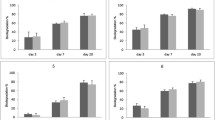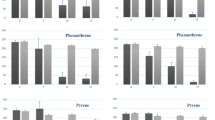Abstract
The existence of polycyclic aromatic hydrocarbons in the various environments has aroused great environmental concerns due to their potential hazards to human health. The presence of polycyclic aromatic hydrocarbons in aquifer is particularly sensitive where groundwater is used as a source of potable water. Anaerobic biodegradation of polycyclic aromatic hydrocarbons is an attractive option for remediation of contaminated aquifer sediment. Bacterial and archaeal community structures of phenanthrene-degrading aquifer sediment under methanogenic condition were investigated using clone library analysis in combination with microcosm study. The bacterial members were all affiliated with γ-Proteobacteria. Phylum Euryarchaeota was the predominant archaeal group, represented by genera Methanosarcina, Methanobacterium and Thermogymnomonas. Both bacteria (genera Citrobacter and Pseudomonas) and archaea (genus Methanosarcina) might have links to phenanthrene degradation process. This work might provide some new insights into developing strategies for the isolation of the putative polycyclic aromatic hydrocarbons degraders under methanogenic condition and bioremediating polycyclic aromatic hydrocarbons in leachate-contaminated aquifer sediment.


Similar content being viewed by others
References
Abdulsalam S, Bugaje IM, Adefila SS, Ibrahim S (2011) Comparison of biostimulation and bioaugmentation for remediation of soil contaminated with spent motor oil. Int J Environ Sci Technol 8(1):187–194
Ammar E, Nasri M, Medhioub K (2005) Isolation of Enterobacteria able to degrade simple aromatic compounds from the wastewater from olive oil extraction. World J Microb Biotechnol 21(3):253–259
An SY, Min SK, Cha IH, Choi YL, Cho YS, Kim CH, Lee YC (2002) Decolorization of triphenylmethane and azo dyes by Citrobacter sp. Biotechnol Lett 24(12):1037–1040
Bamforth SM, Singleton L (2005) Bioremediation of polycyclic aromatic hydrocarbons, current knowledge and future directions. J Chem Technol Biotechnol 80(7):723–736
Cébron A, Beguiristai T, Faure P, Norini MP, Masfaraud JF, Leyval C (2009) Influence of vegetation on the in situ bacterial community and polycyclic aromatic hydrocarbon (PAH) degraders in aged PAH-contaminated or thermal-desorption-treated soil. Appl Environ Microbiol 75(19):6322–6330
Chang W, Um YS, Holoman TRP (2005a) Molecular characterization of anaerobic microbial communities from benzene-degrading sediments under methanogenic conditions. Biotechnol Progr 21(6):1789–1794
Chang W, Um YS, Holoman TRP (2005b) Molecular characterization of polycyclic aromatic hydrocarbon (PAH)-degrading methanogenic communities. Biotechnol Progr 21(3):682–688
Chang W, Um YS, Holoman TRP (2006) Polycyclic aromatic hydrocarbon (PAH) degradation coupled to methanogenesis. Biotechnol Lett 28(6):425–430
Chang YT, Lee JF, Chao HP (2007) Variability of communities and physiological characteristics between free-living bacteria and attached bacteria during the PAH biodegradation in a soil/water system. Eur J Soil Biol 43(5–6):283–296
Chen AC, Imachi H, Sekiguchi Y, Ohashi O, Harada H (2003a) Archaeal community compositions at different depth (up to 30 m) of a municipal solid waste landfill in Taiwan as revealed by 16S rDNA cloning analyses. Biotechnol Lett 25(9):719–724
Chen AC, Ueda K, Sekiguchi Y, Ohashi A, Harada H (2003b) Molecular detection and direct enumeration of methanogenic Archaea and methanotrophic bacteria in domestic solid waste landfill soils. Biotechnol Lett 25(18):1563–1569
Ficker M, Krastel K, Orlicky S, Edwards E (1999) Molecular characterization of a toluene-degrading methanogenic consortium. Appl Environ Microbiol 65(12):5576–5585
Gilles M, Monique A, Jean-Claude B, Philippe C (2010) Response of an archaeal community from anoxic coastal marine sediments to experimental petroleum contamination. Aquat Microb Ecol 59(1):25–31
Grishchenkov VG, Slepen’kin AV, Boronin AM (2002) Anaerobic degradation of biphenyl by the facultative anaerobic strain Citrobacter freundii BS2211. Appl Biochem Microbiol 38(2):125–128
Gros R, Poly F, Monrozier LJ, Faivre P (2003) Plant and soil microbial community responses to solid waste leachates diffusion on grassland. Plant Soil 255(2):445–455
Großkopf R, Janssen PH, Liesack W (1998) Diversity and structure of the methanogenic community in anoxic rice paddy soil microcosms as examined by cultivation and direct 16S rRNA gene sequence retrieval. Appl Environ Microbiol 64(3):960–969
Haritash AK, Kaushik CP (2009) Biodegradation aspects of polycyclic aromatic hydrocarbons (PAHs): a review. J Hazard Mater 169(1–3):1–15
He R, Ruan AD, Jiang CJ, Shen DS (2008) Responses of oxidation rate and microbial communities to methane in simulated landfill cover soil microcosms. Bioresour Technol 99:7192–7199
Huang LN, Zhou H, Chen YQ, Luo S, Lan CY, Qu LH (2002) Diversity and structure of the archaeal community in the leachate of a full-scale recirculating landfill as examined by direct 16S rRNA gene sequence retrieval. FEMS Microbiol Lett 214(2):235–240
Jiries A, Rimawi O, Lintelmann J, Batarseh M (2005) Polycyclic aromatic hydrocarbons (PAH) in top soil, leachate and groundwater from Ruseifa solid waste landfill, Jordan. Int J Environ Pollut 23(2):179–188
Kim M, Bae SS, Seol M, Lee JH, Oh YS (2008) Monitoring nutrient impact on bacterial community composition during bioremediation of anoxic PAH-contaminated sediment. J Microbiol 46(6):615–623
Li CH, Wong YS, Tama NFY (2010) Anaerobic biodegradation of polycyclic aromatic hydrocarbons with amendment of iron (III) in mangrove sediment slurry. Bioresour Technol 101(21):8083–8092
Maidak BL, Cole JR, Lilburn TG, Parker CT, Saxman PR, Farris RJ, Garrity GM, Olsen GJ, Schmidt TM, Tiedje JM (2001) The RDP-II, Ribosomal Database Project. Nucleic Acids Res 29:173–174
Meckenstock RU, Safinowski M, Griebler C (2004) Anaerobic degradation of polycyclic aromatic hydrocarbons. FEMS Microbiol Ecol 49(1):27–36
Mori K, Sparling R, Hatsu M, Takamizawa K (2003) Quantification and diversity of the archaeal community in a landfill site. Can J Microbiol 49(1):28–36
Narde GK, Kapley A, Purohit HJ (2004) Isolation and characterization of Citrobacter strain HPC255 for broad-range substrate specificity for chlorophenols. Curr Microbiol 48(6):419–423
Ren Y, Peng LH, Deng LJ, Wei CH (2009) Isolation and characterization of Citrobacter farmeri sco1, a novel m-cresol-degrading strain. Environ Eng Sci 26(10):1489–1495
Ridgeway HF, Safarik J, Phipps D, Carl P, Clark D (1990) Identification and catabolic activity of well-derived gasoline degrading bacteria and a contaminated aquifer. Appl Environ Microbiol 56(11):3565–3575
Savelieva O, Kotova I, Roelofsen W, Stams AJM, Netrusov A (2004) Utilization of aminoaromatic acids by a methanogenic enrichment culture and by a novel Citrobacter freundii strain. Arch Microbiol 181(2):163–170
Singh C, Lin J (2008) Isolation and characterization of diesel oil degrading indigenous microrganisms in Kwazulu-Natal, South Africa. Afr J Biotechnol 7(12):1927–1932
Sponza DT, Cigal C (2008) Relationships between anaerobic consortia and removal efficiencies in an UASB reactor degrading 2,4 dichlorophenol (DCP). J Environ Manag 87(1):177–192
Tamura K, Dudley J, Nei M, Kumar S (2007) MEGA4, molecular evolutionary genetics analysis, MEGA software version 4.0. Mol Biol Evol 24:1596–1599
Tian YJ, Yang H, Wu XJ, Li DT (2005) Molecular analysis of microbial community in a groundwater sample polluted by landfill leachate and seawater. J Zhejiang Univ Sci B 6(3):165–170
Wang Q, Garrity GM, Tiedje JM, Cole JR (2007) Naive Bayesian classifier for rapid assignment of rRNA sequences into the new bacterial taxonomy. Appl Environ Microbiol 73(16):5261–5267
Wang H, Su JQ, Zheng XW, Tian Y, Xiong XJ, Zheng TL (2009) Bacterial decolorization and degradation of the reactive dye Reactive Red 180 by Citrobacter sp CK3. Int Biodeterior Biodegrad 63(4):395–399
Yang Y, McCarty PL (1998) Competition for hydrogen within a chlorinated solvent dehalogenating anaerobic mixed culture. Environ Sci Technol 32(22):3591–3597
Yousefi Kebria D, Khodadadi A, Ganjidoust H, Badkoubi A, Amoozegar MA (2009) Isolation and characterization of a novel native Bacillus strain capable of degrading diesel fuel. Int J Environ Sci Technol 6(3):435–442
Yu R, Gan P, MacKay AA, Zhang SL, Barth F, Smets BF (2010) Presence, distribution, and diversity of iron-oxidizing bacteria at a landfill leachate-impacted groundwater surface water interface. FEMS Microbiol Ecol 71(2):260–271
Yuan SY, Chang JS, Yen JH, Chang BV (2001) Biodegradation of phenanthrene in river sediment. Chemosphere 43(3):273–278
Zhang SY, Wang QF, Xie SG (2011) Microbial community changes in contaminated soils in response to phenanthrene amendment. Int J Environ Sci Technol 8(2):321–330
Acknowledgments
This work was supported by the National Natural Science Foundation of China (No. 50979002).
Author information
Authors and Affiliations
Corresponding author
Rights and permissions
About this article
Cite this article
Zhang, S.Y., Wang, Q.F. & Xie, S.G. Molecular characterization of phenanthrene-degrading methanogenic communities in leachate-contaminated aquifer sediment. Int. J. Environ. Sci. Technol. 9, 705–712 (2012). https://doi.org/10.1007/s13762-012-0098-7
Received:
Revised:
Accepted:
Published:
Issue Date:
DOI: https://doi.org/10.1007/s13762-012-0098-7




